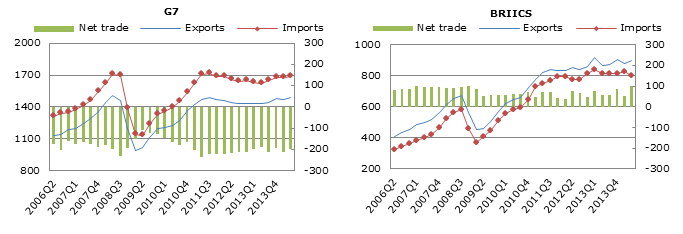News
Merchandise trade broadly stable in Q2 2014, with diverging patterns across major economies

Total merchandise trade of the G7 and BRIICS economies combined was broadly stable in the second quarter of 2014, with exports rising 1.5% and imports falling 0.8% compared with the previous quarter.
This broad stability however masked diverging patterns across countries.
In the United States and Canada, both exports (up 2.2% and 4.7%, respectively) and imports (up 2.7% and 4.9%, respectively) rose strongly in the second quarter of 2014. By contrast, in Japan, merchandise trade declined, with both imports and exports contracting (by 7.8% and 0.5% respectively) as the effects of the April's increase in the consumption tax unwound.
Among the major EU countries, in Germany exports increased by 0.5% and imports decreased by 1.3%. In France both exports and imports fell (by 0.6% and 0.2%, respectively). In Italy exports remained broadly flat while imports rose (by 1.4%). In the United Kingdom both exports and imports rose compared with the previous quarter (by 0.4% and 1.1%, respectively).
In China, exports rose by 2.9% and imports contracted by 4.1%, partly reflecting lower commodity prices. Exports also rose and imports fell in Russia (by 2.8% and minus 3.8%, respectively) and in Brazil (by 0.7% and minus 6.6%, respectively). In Indonesia and South Africa both exports and imports declined (by 3.4% and 0.9%, for Indonesia and by 3.9% and 2.0% for South Africa).
|
Merchandise trade in US$ billion |
|
|
|
Source: Statistics on International Trade Database, OECD |





